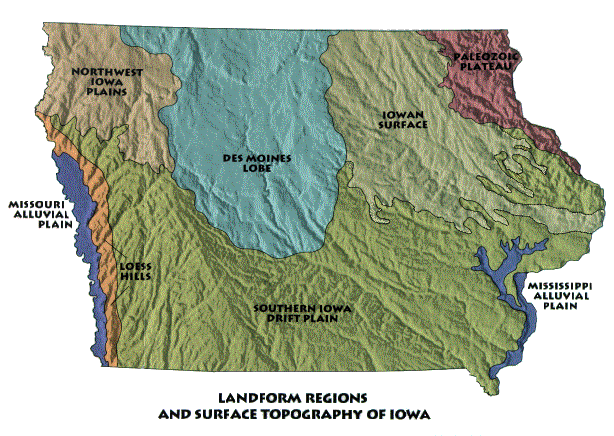Encyclopedia Dubuque
"Encyclopedia Dubuque is the online authority for all things Dubuque, written by the people who know the city best.”
Marshall Cohen—researcher and producer, CNN
Affiliated with the Local History Network of the State Historical Society of Iowa, and the Iowa Museum Association.
GLACIERS
GLACIERS. Iowa’s geologic history lies buried. The deeper, older and least frequently seen portions of this history consist of sandstone, limestone, dolomite and shale. In places, these are over 3,000 feet thick.
These rocks originated as layers of loose sediment settling in shallow seas and along coastal and floodplain environments that occupied Iowa between 74 million years ago (Cretaceous) and 530 million years ago. This sediment hardened into rock containing fossil remains of past animal and plant life. Fossil-bearing rocks are found among the abundant outcrops of northeastern Iowa, a topographic region called the Paleozoic Plateau. Also, bedrock is occasionally exposed along the state's river valleys, at road cuts, and in quarries. Elsewhere across the state, the bedrock surface is covered with younger glacial-age materials. As a result, much of our information about Iowa's bedrock geology comes from rock samples brought up to the land surface during the drilling of wells.
Iowa’s bedrock geology map shows rocks from younger periods overlapping older rocks. Most of the rock units are dipping gently to the southwest, and this bedrock structure, together with surface erosion, contributes to the irregular bedrock surface crossing rock units of different ages.
Two small, but important features interrupt this general bedrock pattern. The first is in the far northwest corner of Iowa. An ancient ridge of silica-cemented sandstone pokes to the land surface. At 1.6 billion years of age (Precambrian), these scattered outcrops of hard, reddish Sioux Quartzite are the oldest bedrock exposed anywhere in Iowa. Elsewhere the Precambrian rocks are usually igneous and metamorphic types; they lie deeply buried by the thick sedimentary strata.
The second irregularity in the bedrock surface is a 23-mile-diameter circular feature known as the Manson Impact Structure in Pocahontas and Calhoun counties. Here, a meteor impact 74 million years ago caused massive disruption of the Cretaceous bedrock and older strata beneath. This event was so forceful that it brought deeply buried Precambrian granite to the land surface. The crater and its distorted rocks are covered with over 100 feet of glacial deposits, so are not visible on today’s landscape.
The present land surface across Iowa is dominated by loose materials much younger than the bedrock beneath. These materials consist of sediment originating from ice sheets, melt water streams, and strong winds during a series of glacial events between 2.5 million and 10,000 years ago. This familiar “dirt” consists of pebbly clay, sand, gravel, and abundant silt, which over time have weathered into Iowa’s productive loamy soils. These easily eroded “Ice Age” deposits create the gently rolling appearance of much of the Iowa (and Midwestern) landscape.
Differences observed in the landscapes across Iowa are the result of overlapping glacial advances with the effects of erosion and wind. The last glacier to enter the state formed the Des Moines Lobe region (map, above) between 14,000 and 12,000 years ago. Knobby moraine ridges and numerous wetlands are the direct result of a stagnant, disintegrating ice sheet.
The rest of Iowa’s land surface is formed of much older glacial deposits, left between 2.5 million and 500,000 years ago. Across southern Iowa, erosion has carved these deposits into steeply rolling, well-drained terrain (Southern Iowa Drift Plain). Across the northern half of Iowa, however, these same deposits were leveled by intense erosional activity during a peak of glacial cold between 21,000 and 16,000 years ago. The result is more gently rolling terrain across the Iowan Surface and Northwest Iowa Plains, which lie on either side of (and beneath) the Des Moines Lobe. About the same time, strong winds swept glacially ground "rock flour" from river floodplains. This airborne silt was deposited as loess across much of the Iowa landscape, and unusually thick deposits along the Missouri Valley in western Iowa became the steep, picturesque ridges of the Loess Hills.
The flow of rivers is the primary geologic process affecting Iowa’s landscape today. Many valleys, such as the Missouri and Mississippi alluvial plains, are much wider than the rivers within them. This indicates excavation by flood flows during glacial melting. Abundant gravel deposits along the valleys also reflect the power of melt water to move coarse material. Even modern floods demonstrate how earth materials are eroded from one portion of a valley, sorted by flowing water, and redeposited downstream. Episodes of sediment transport by rivers are an on-going part of the geologic evolution of Iowa.
Iowa’s earth history continues to be shaped by slow, gradual processes as well as by brief, intense events.


